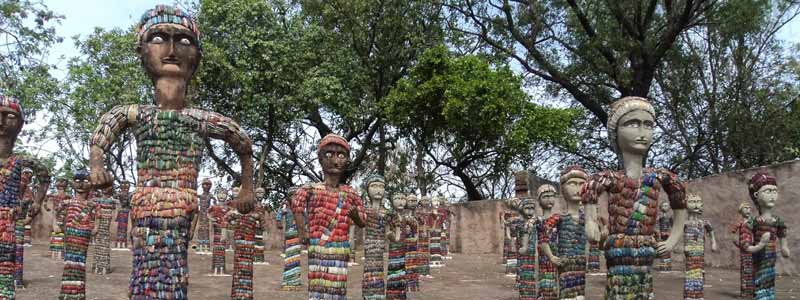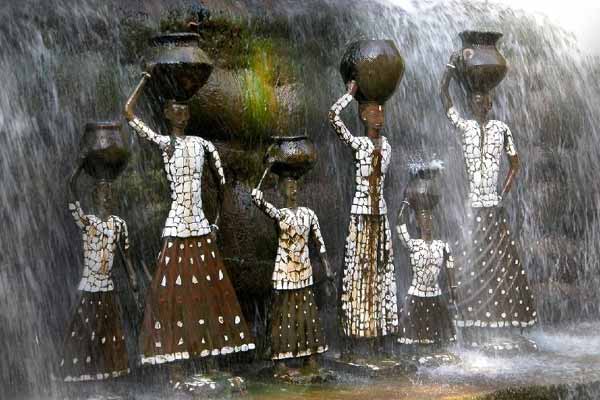Rock Garden Chandigarh It’s a surreal experience to visit the Rock Garden, which is a tribute to human imagination, innovation, and perseverance. The garden is an open-air exhibition hall created by Nek Chand, a single artist. It consists of a series of interconnected courtyards, each of which houses a collection of sculptures with similar themes made from a variety of raw materials. In the early 1960s, Nek Chand started working on his Rock Garden Chandigarh at night after finishing work at his daily day job, according to local legend. He made sculptures out of whatever raw materials he could get his hands on.
Since the land on which he had begun carving out a small garden for himself was not legitimately his, he worked in secret for fear of being caught and reprimanded. When the authorities found out, they were astounded to see the excellent work he had accomplished on his own. Fortunately, they decided to recognise his brilliance and pay him for his artistic work, allowing him to devote his full attention to the development of the Rock Garden Chandigarh. He was also given a staff of around 50 men to help him with the massive undertaking. Indeed, Nek Chand established a local network through which broken crockery and discarded materials could be sent to him and recycled into these magnificent sculptures.
The Rock Garden’s unassuming entrance is deceiving at best. Upon entering, one is greeted by a variety of arrangements and sculptures. There are large collections, dreamlike arrangements of rocks and sculptures, ranging from ethnic statues to a party of astronauts seated with their legs crossed. It can be both a ride to the land of dreams and a descent down Alice’s rabbit hole. The waterfalls, bridges, alleys and cavernous pathways make it an adventure one is not likely to forget.

History
Chandigarh Rock Garden was constructed by Nek Chand Saini, who recycled the scrap and other waste material to build it. He was managed to keep this place in hiding for 18 years before its discovery. Since his work was illegal, the Rock Garden was in danger of getting demolished. But due to strong public opinion in his favour, the park was officially opened to the public in 1976.
As you enter through the unassuming entrance of the Rock Garden Chandigarh, you will see many sculptures made of rocks placed on the sidewalls of the trail. The sidewall is adorned by the broken pieces of the ceramic pots.
Chandigarh Rock Garden is designed on the fantasy of a lost kingdom. It has a couple of artificial waterfalls, small houses, palaces, and many different doorways and pathways, each opening to different varieties of exhibits. The entrance and exit gates are parallel to each other and one has to follow the trail to explore the garden.
Entry Fee & Ticket
Now that we are clear about the timings of Rock Garden Chandigarh, it is time to know the expenditure that would be involved in making a visit to this popular tourist attraction. Considering the fascinating history of the garden and the creative genius utilized in building the site, one might expect it to be moderately expensive to visit this artistic marvel; however, the entry fee of Rock Garden, Chandigarh is surprisingly low!
So, even when you’re on the lowest of your travel budgets, you won’t have to think twice before visiting this place. Whether you’re a student with just some pocket money in hand or have to bear the expenses for a huge family picnic, you need not worry, as Rock Garden, Chandigarh’s ticket price is merely 30 rupees! And for kids? Well, just pay 10 rupees for a child and let them enjoy and have a good time.
How to Reach:
By Air : The airport is 11 km from downtown. Taxis are available for Airport transfer. Indian Airlines, Jet Airways and Air Deccan connects Chandigarh with New Delhi the National Capital. Rock Garden Chandigarh Tourism has well maintained Tourist Information Centre at the Airport.
By Train : Chandigarh is linked with New Delhi, the National Capital by Rail. The Chandigarh Railway Station is 8 Kms from the city centre in Sector 17. The twice daily Shatabdi, Jan Shatabdi and Himalayan Queen connects New Delhi and Chandigarh. Paschim Express connects the city to Mumbai, Sadbhavna to Lucknow, Kerala Sampark Kranti to Kerala and Chennai Express to Chennai.
By Road : Chandigarh is well connected by road and buses provide an important transport link. There are services from various states such as- Haryana, Punjab, Himachal, and Delhi. It is a gateway to Himachal Pradesh as one can reach hill stations like Kasauli, Chail, Shimla etc within in a few hours drive. The hill stations Kullu & Manali with Rohtang Glacier are accessible from Rock Garden Chandigarh. The Union Territory of Chandigarh is well served by an excellent network of roads.
The National Highways No. 21 (Ambala-Kinnaur) and 22 (Chandigarh-Leh) are the chief road arteries linking Chandigarh with the rest of the country. The city is within motorable distance from a number of popular towns and pilgrimage centres. Buses of several State Road Transport Corporations connect Chandigarh with many cities and towns of neighbouring states. Buses may be air-conditioned, deluxe, semi-deluxe or ordinary. The Inter-State Bus Terminus (ISBT) is located in Sector 17 (City Centre).
